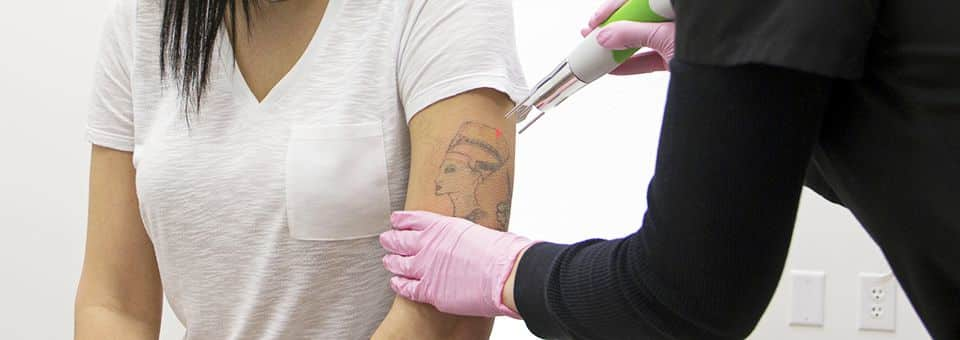Tattoo Removal
I Hate My Permanent Makeup
How Can I Get Rid Of It For Good?
Remember when permanent makeup was all the rage? Well, things have changed—and for good reason.
While permanent makeup removal can be achieved using chemical peels, dermabrasion, electrocautery, and surgical removal, laser removal is far superior
If your permanent makeup has bled and spread or looks dated, don’t fret. Laser permanent makeup removal can remove even the most stubborn inks. It can remove permanent makeup most places on the face as well, including the eyebrows. While permanent makeup removal can be achieved using chemical peels, dermabrasion, electrocautery, and surgical removal, laser removal is far superior, given that permanent makeup is simply a kind of tattoo.
Although laser permanent makeup removal is similar to laser tattoo removal, it does pose more of a challenge. Permanent makeup usually uses a modified version of tattoo ink, which can oxidize during treatment, becoming more difficult to remove. Because permanent makeup is typically applied to particular areas of the skin, this can lead to some permanent side effects. For example, laser removal for permanent eyebrows may result in permanent hair removal in the eyebrow region. Similarly, laser removal for permanent eyeliner can be very challenging because the tissue is so delicate and so close to the eyes. Lasers are rarely used to remove permanent lip liner or full color lips due to the high density of blood vessels on the lips.
Don’t let these challenges discourage you, however. Recent advancements in laser technology means that most permanent makeup can be safely and effectively removed.
Permanent Makeup Removal 101
Laser permanent makeup removal works by targeting pigment colors in the skin’s dermis, the layer of skin between the epidermis and subcutaneous tissues. Light beams radiated by the laser are absorbed by tattoo pigments, which then fragment. The body then absorbs and eliminates the pigment fragments.
The Q-switch is the most common type of laser used in tattoo removal. It produces pulses of light boasting an extremely high peak power. Several types of Q-switch lasers exist, and each one targets a different color spectrum at different wavelengths. Because Q-switch lasers are so precise and intense, tattoo pigments fragment instantly, resulting in minimal damage to the surrounding tissue.
The Q-switch Nd:YAG laser is the most common laser used for permanent makeup removal. Its wavelength is longer than other lasers, meaning that it can penetrate deeper into the dermis, leaving the surrounding skin unharmed. This type of laser is designed to treat stubborn ink colors such as reds, greens, and yellows. It can also effectively remove black and brown ink. The Q-switch Nd:YAG laser carries the least risk for hypopigmentation and other skin complications. However, if your permanent makeup contains zinc oxide ink, it may react with the laser and actually darken. Don’t worry, though. Nearly every good physician does a patch test prior to treatment.
Am I a Good Candidate?
Most likely. Because each kind of permanent makeup is unique, removal techniques—including the type of laser used—must be tailored to your particular needs. Black, blue, red and orange are easier to remove. But some permanent makeup inks are especially stubborn. Green, yellow and fluorescent inks are notoriously difficult to remove, as are yellow, flesh color, and white. Their absorption spectra often fall outside most lasers’ targeted color spectrums. What’s more, permanent makeup inks sometimes contain chemicals like iron oxide or titanium dioxide, which makes it even more difficult for laser beams to “explode” color pigments.
Medium or fair-skinned people react well because the laser can selectively target ink.
You can consider yourself a good candidate for permanent makeup removal (meaning you won’t suffer scarring) if you have medium to fair skin and a tattoo that contains dark (but not dense) ink and a superficial ink depth. Why? Medium or fair-skinned people react well because the laser can selectively target ink. You’re also a good candidate if your permanent makeup is not located on your lips or in sensitive areas like your eyelids – it’s too risky treating these areas because of the high percentage of blood vessels and delicate tissue. The easiest type of permanent makeup to remove is on your eyebrows.
Prepping for Permanent Makeup Removal
Before a permanent makeup removal session, your physician will determine which type of laser to use and how many treatments you’ll need. The number of required treatments is based on the permanent makeup’s age, size, type, and pigment depth. Before determining an appropriate treatment plan, your physician will first test out the laser on your skin to see how it reacts.
So what happens during a laser permanent makeup removal treatment? Before the session starts a medical professional will apply an anesthetic cream, and you’ll be given protective eye gear to wear, along with a cooling device. The medical professional will then gently place a hand piece against your skin and deliver laser pulses to the tattoo pigment. With each laser pulse, most people experience a sensation similar to a rubber band snapping against their skin. The amount of laser pulses depends on the size and location of your permanent makeup, but most treatment sessions only last a few minutes.
You may experience minor bleeding, redness, swelling and blistering for several hours or days following treatment. The next several weeks may see the treated area flaking, peeling and scabbing. Handle the treatment site gently. While the site is healing, you should avoid sun exposure and public swimming pools. You also should refrain from wearing cosmetics or using any special creams or treatments on your face. Once the skin has completely healed (usually four to six weeks after treatment), you can undergo additional sessions.
Laser Permanent Makeup Removal That Gets Results
There’s no other choice, really. Laser permanent makeup removal is the only safe and effective method to remove unwanted permanent makeup on your face. After a series of successful laser treatments, most permanent makeup is pretty much gone. Keep in mind, however, that how fast your permanent makeup disappears depends on its color pigments, depth, location and age. But even stubborn cases aren’t hopeless. Though colors such as yellow, green, white or beige are more difficult to remove, they can certainly be faded. The same goes for ink that rests deep within the dermis.
The good news is that the technology just keeps on getting better. Newer laser technologies such as the Nd:YAG and Q-switch can now effectively treat even the most stubborn ink colors; in fact, they’re the preferred method for removing permanent makeup.
So what are you waiting for? Schedule your free, no-obligation laser permanent makeup removal consultation at LaserAway today by emailing LaserAway.net or calling the staff at LaserAway at (888) 965-2737.


